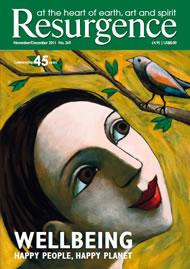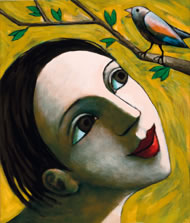I have been making pictures of my everyday life, like a visual diary, for the past 30 years. I use a variety of media including many printmaking techniques and types of paint, choosing the most appropriate for the feeling I want to convey in each image. I work entirely from memory and don’t use any visual reference like photographs or working from life, although I do draw from life as an exercise. This is because I want to express what things feel like rather than what they look like.
Although my pictures are self-portraits, I hope that people see themselves, not me, in them. We are all much more alike than we think. My pictures are a celebration of ordinariness and are also about loss. This might not be obvious, because they seem very happy, but the impetus for me is to try to hold onto those very small moments that may not seem special at the time but are what I would miss most if everything were taken away from me.
I grew up with a very strong awareness of how lucky I am, as my father’s family were Hungarian Jewish refugees from war-torn Europe who lost everything (including family members) apart from their lives. I think there is too little respect for the art of happiness. Just as drama is often seen as more worthy than comedy, everyone seems to want to express darkness and pain at the moment.
I know my work is quite unfashionable, but as an artist this is not something I can do anything about. I just do what I need to do, and it is a lovely reward if other people want to live with it or look at it.
Composition – by which I mean the design of the picture, where it begins and ends at the edges, and the shapes that make up the image – is extremely important to me. The more tightly and carefully designed the internal space is, the less fleeting and more of an object the painting becomes.
I am greatly influenced by early Renaissance Italian painters like Piero della Francesca and Fra Angelico, and by Japanese ukiyo-e printmakers, especially Utamaro. These pictures radiate calm and harmony and are rigorously designed, although they can seem very simple because everything is in exactly the right place.
When I draw as preparation for a print or painting, I use an eraser as much as I use a pencil, constantly correcting until I feel everything settle into a stillness, a bit like putting the last piece in a jigsaw. I don’t expect people to necessarily notice this about my work; I want it to seem simple. But I do hope that my quest for pictorial harmony means that people feel soothed and calmed by the end result.
For more information, visit: www.anitaklein.com









